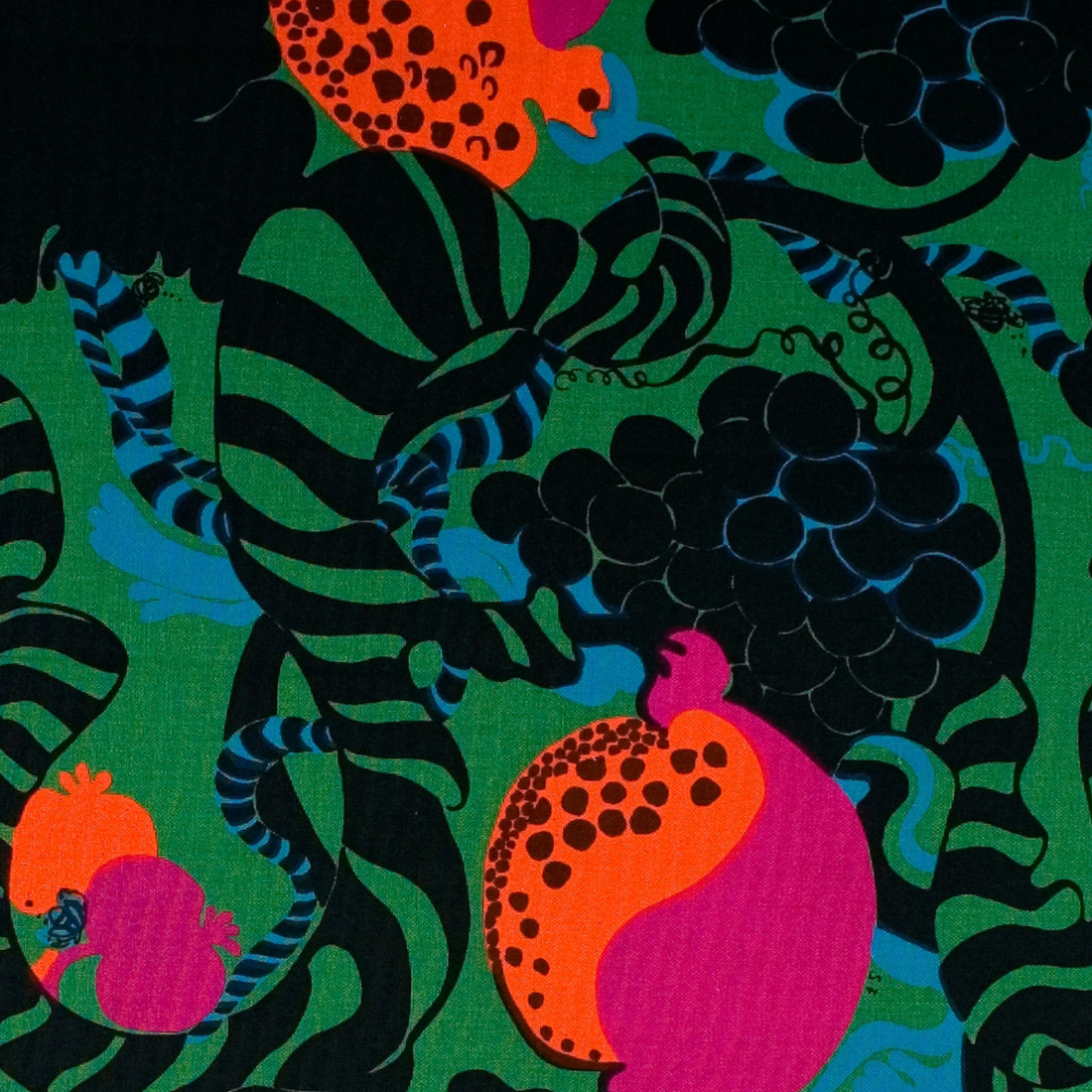
Print, Repeat, Archive: Sven Fristedt’s Work Exhibited in Borås
Sven Fristedt’s patterns have the rare ability to feel both deeply nostalgic and startlingly modern. They carry perhaps a sense of lived experience through memories of curtains in a childhood kitchen, a bold sofa in a neighbour’s house, a duvet cover seen in an old catalogue. Yet, they remain timeless in their rhythm and optimism. On until 5 April 2026, the Textile Museum of Sweden in Borås presents Sven Fristedt – Master of Patterns, a retrospective that brings together seven decades of his work, tracing a career that helped shape Scandinavian textile design as we know it today.

Sven Fristedt in his studio. From "Sven Fristedt – Mästare i mönster" by Anna Lindqvist
Born in 1940, Fristedt studied at Beckmans College of Design and Konstfack in Stockholm before moving to Skåne, where he has lived and worked since his twenties. Early in his career he experimented widely with painting, sculpture, and printmaking, before embracing textile pattern as his primary artistic language. His first industrial designs appeared at the end of the 1950s, and by the 1960s his work had already begun to circulate internationally.
 The POLO armchair upholstered in Sven Fristedt’s 1968 pattern MYRTEN. Courtesy of IKEA
The POLO armchair upholstered in Sven Fristedt’s 1968 pattern MYRTEN. Courtesy of IKEA
A defining chapter of his story began when designer Inez Svensson brought him to IKEA headquarters in Älmhult in the mid-1960s. There, Fristedt met textile leader Inger Nilsson, who invited him to create exclusive prints for the company. The collaboration seemed almost effortless. He opened his briefcase, and from it came the first of many patterns that would enter homes across the world. By 1967, fabrics like TARANTELLA and SOMMARGYLLEN were appearing on IKEA furniture, followed by the monochrome MYRTEN. In the decades that followed, his prints became a hallmark of IKEA’s textile identity.
 Sven Fristedt, ALFI pattern (1970). Re-released in 2024 by IKEA in the Nytillverkad collection, now named ÄNGSFIBBLA. Courtesy of IKEA.
Sven Fristedt, ALFI pattern (1970). Re-released in 2024 by IKEA in the Nytillverkad collection, now named ÄNGSFIBBLA. Courtesy of IKEA.
Many of the designer’s most recognisable works emerged during the 1970s and 1980s: the swirling brilliance of ALFI; the joyful primary forms of BLADHULT, famously used on the KLIPPAN sofa; and the dreamy clouds of MOLN, later adapted into SKYAR to accommodate new rotary printing technology. These designs reflected a cultural moment in Sweden when design was both democratic and expressive, intended for everyday life rather than elite display. Fristedt’s work, full of generous forms and organic movement, was modernism with warmth.
 Sketch: Ride to the Water resources agency, Saudi Arabia. Photo: Design Archive, DA-010364.
Sketch: Ride to the Water resources agency, Saudi Arabia. Photo: Design Archive, DA-010364.
The exhibition in Borås, produced by Kulturen in Lund, presents not only these iconic textiles but also Fristedt’s lesser-known artistic works. Alongside industrially printed fabrics are handmade prints created at Konstnärernas Kollektivverkstad in Malmö, as well as sculptural works and original sketches. Together they reveal the designer’s process: his instinct for composition, his fascination with repetition, and his belief that pattern has emotional power.
 Untitled Pattern, Sven Fristedt
Untitled Pattern, Sven Fristedt
This retrospective also arrives at a moment of renewed appreciation for Fristedt’s legacy. In recent years, IKEA has reissued several of his prints through the Nytillverkad collection: BLADHULT returned as KRYPKORNELL in 2023, ALFI reappeared as SVEDJENÄVA, and in 2025 SKYAR resurfaced as ÄNGSVITVINGE. These revivals demonstrate the ongoing relevance of his work to contemporary interiors, proving that bold pattern has a place in today’s design language.
It is fitting that the exhibition takes place at the Textile Museum of Sweden, an institution founded to preserve the country’s textile heritage as the industry declined in the 1960s. Once housed in former factories, now part of the Textile Fashion Center, the museum stands as a bridge between industrial history and cultural memory, with Fristedt’s work belonging here as a living chapter in Sweden’s design story.
-
Further information:
Sven Fristedt – Master of Patterns is on until 5 April 2026, at the Textile Museum of Sweden, Borås
Further reading: Selvedge Issue 127, Aurora
-
Image Credits:
Lead: "Plexus", design Sven Fristedt. Curtain fabric 120 cm wide. Large check print in 6 colours. Quality grosgrain. Film print (handprint). Handprinted in Sweden. Plinon Sanfor.
All further images as credited in photo captions.
